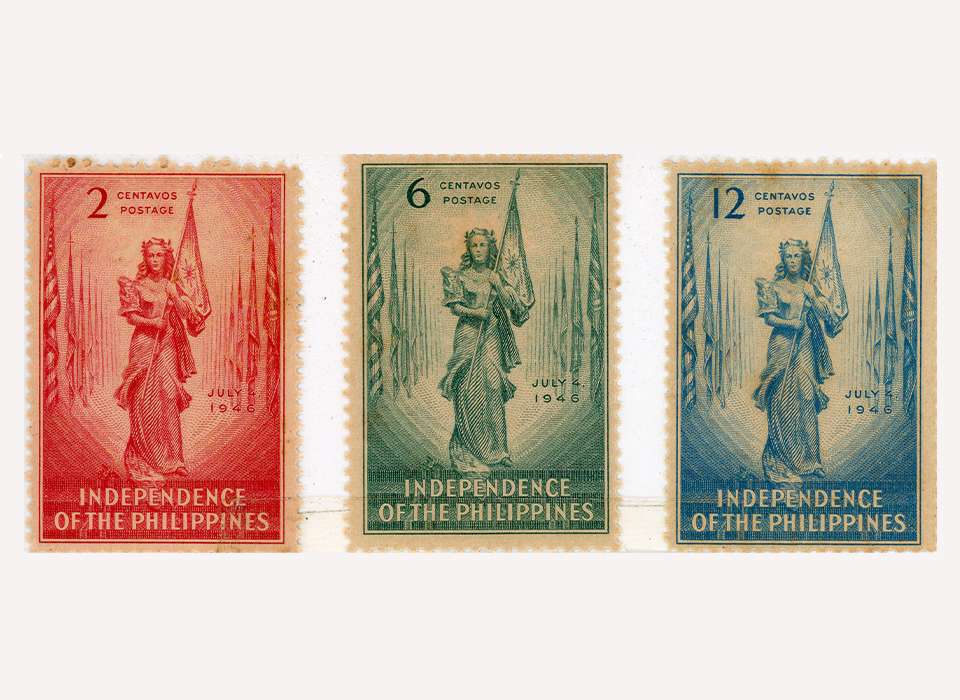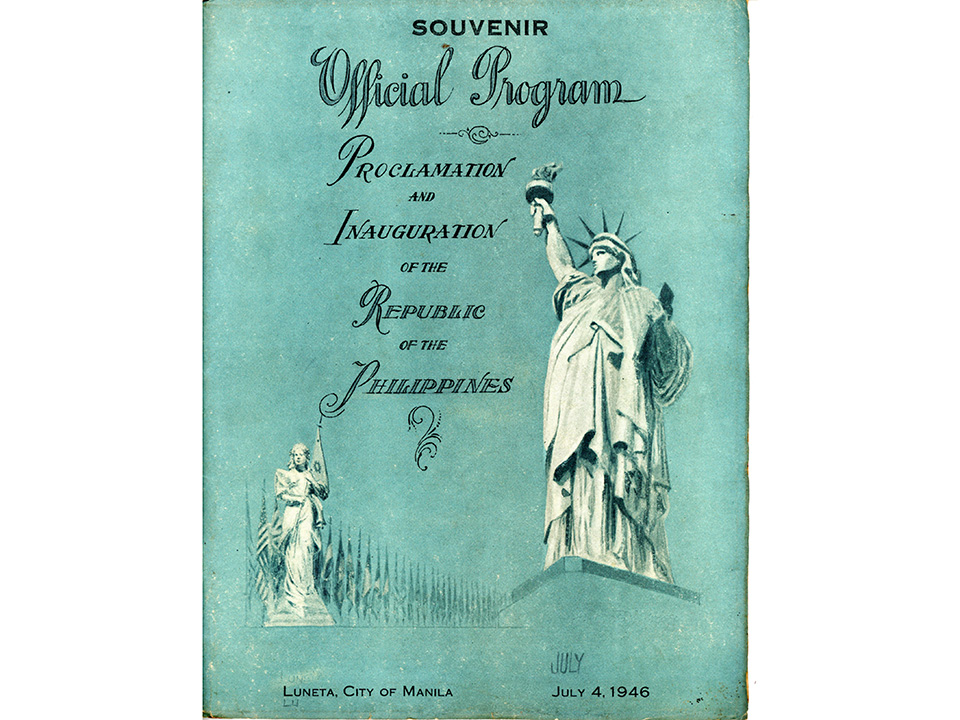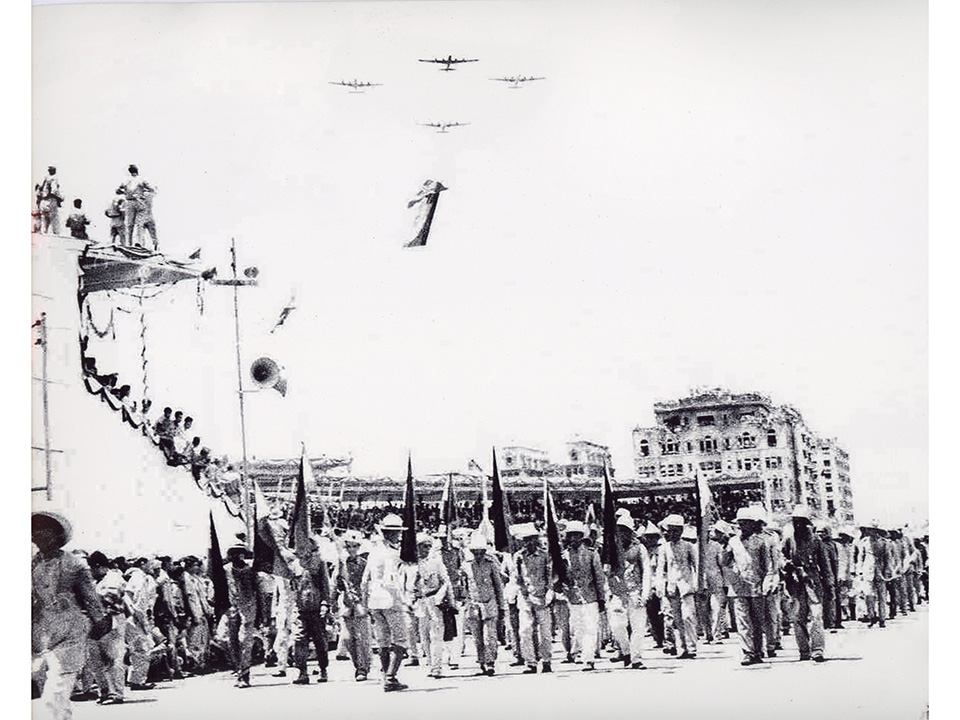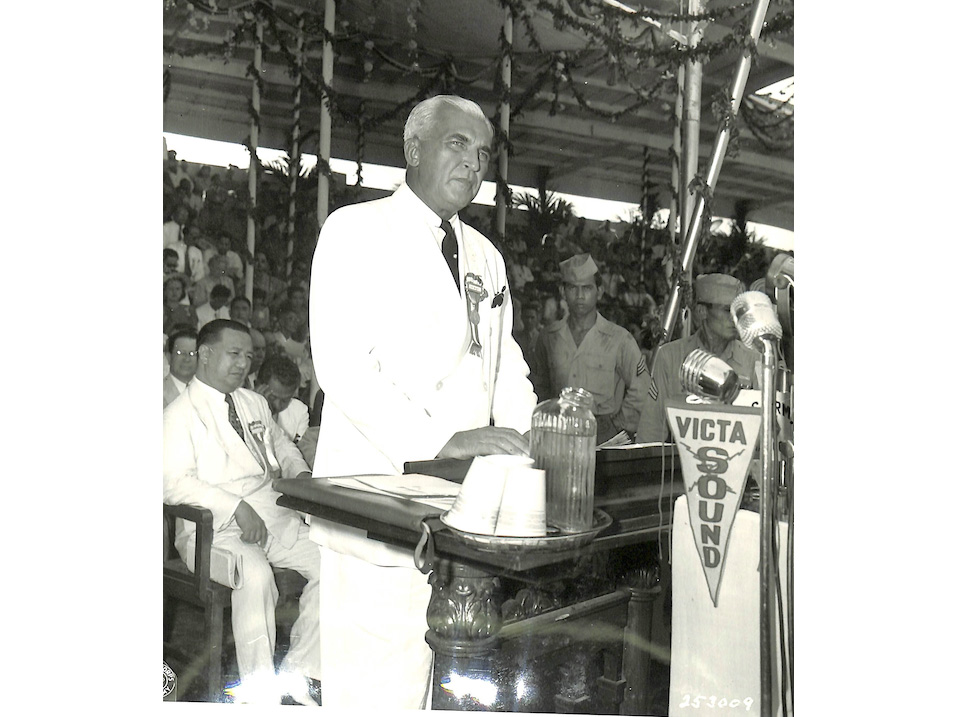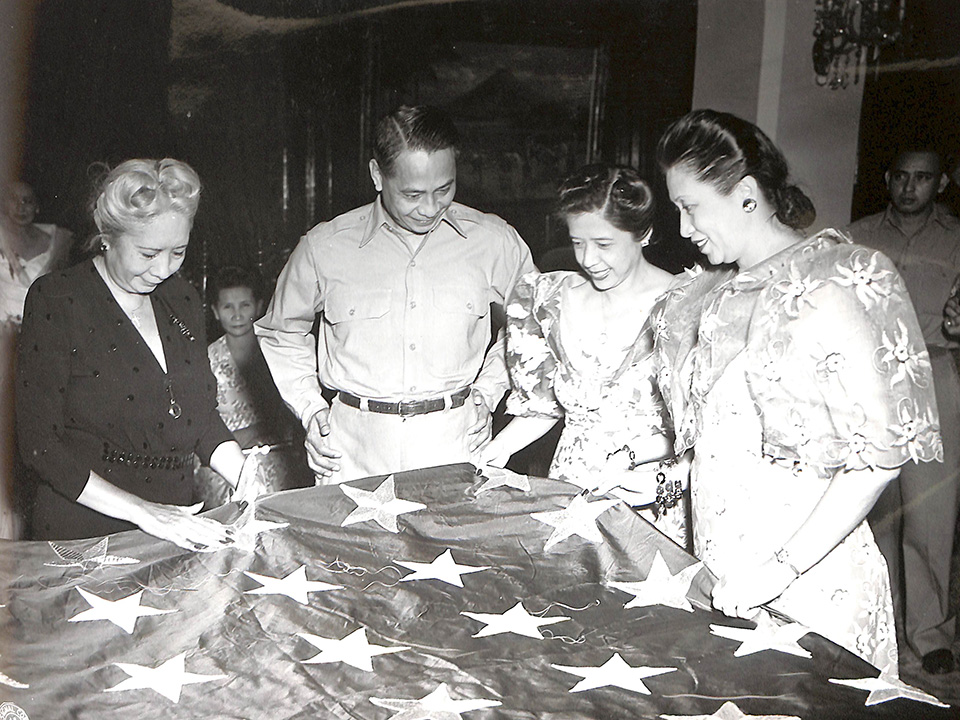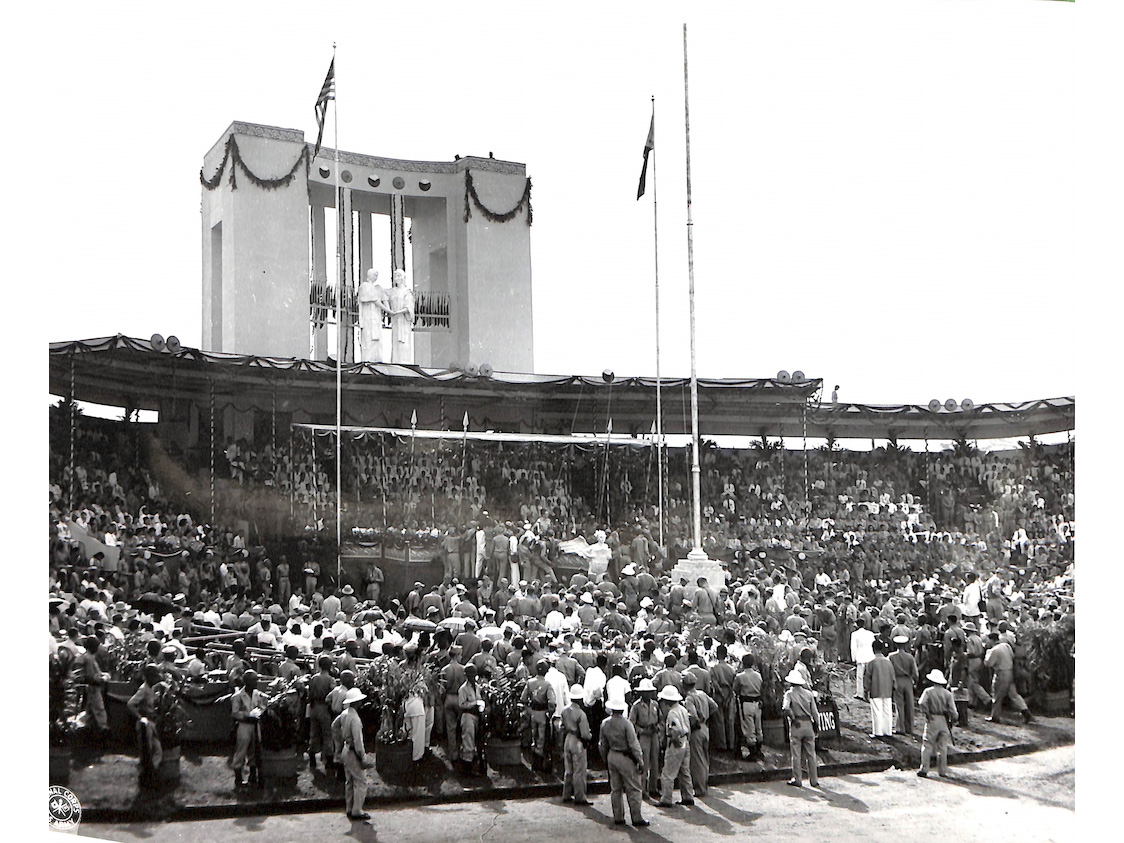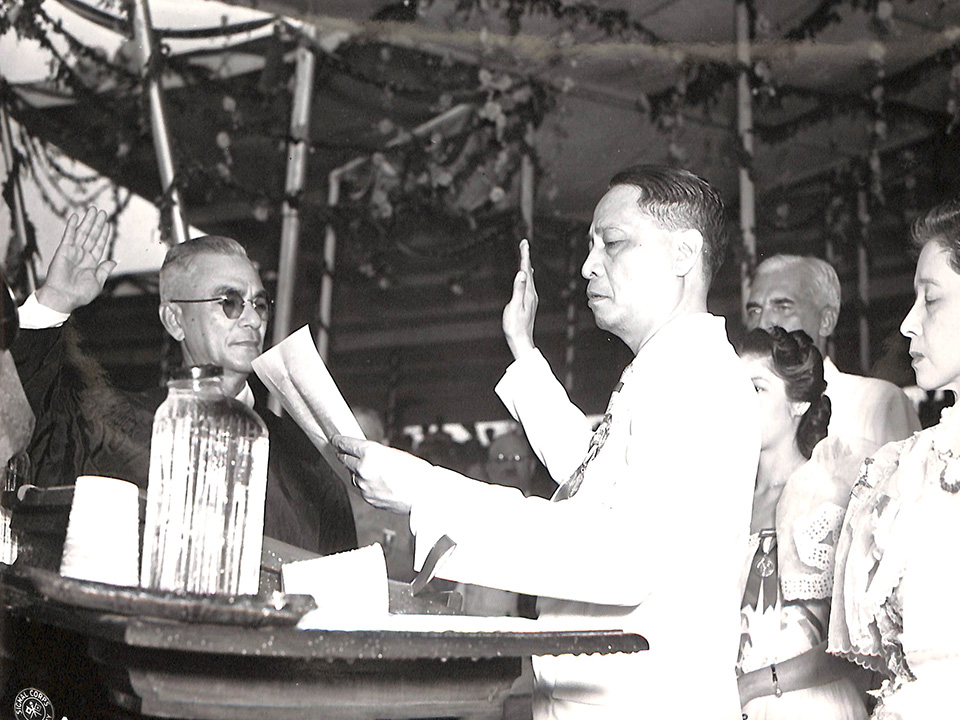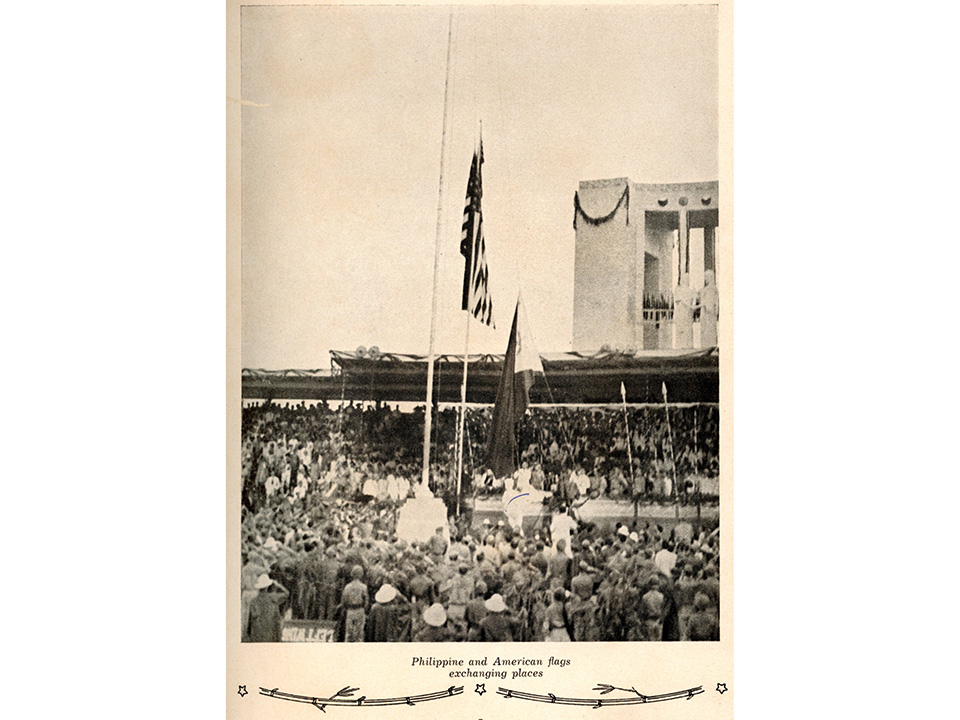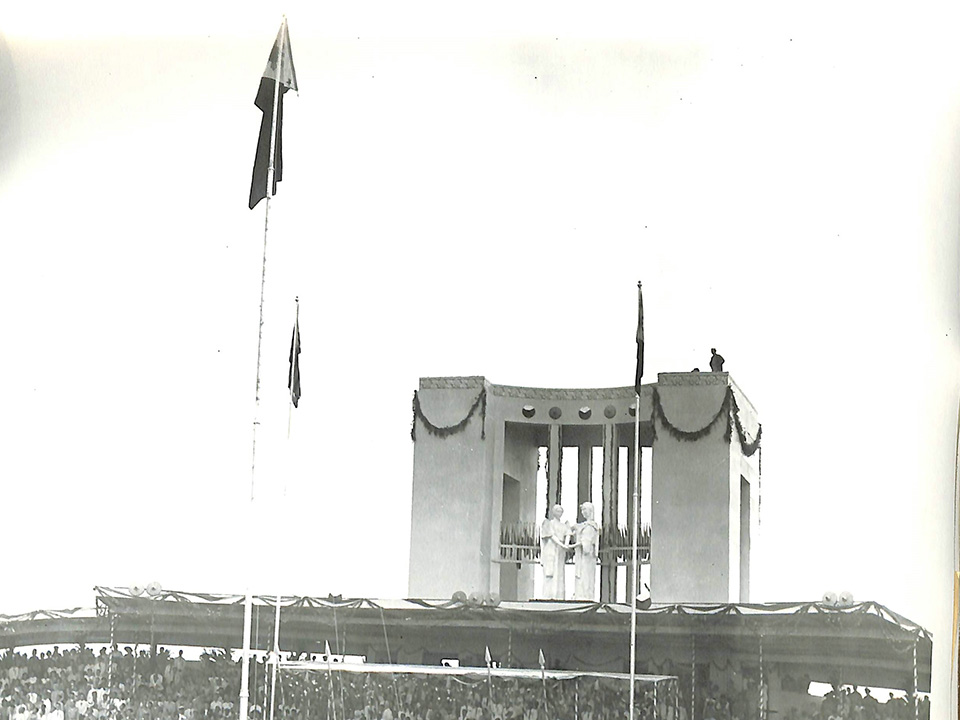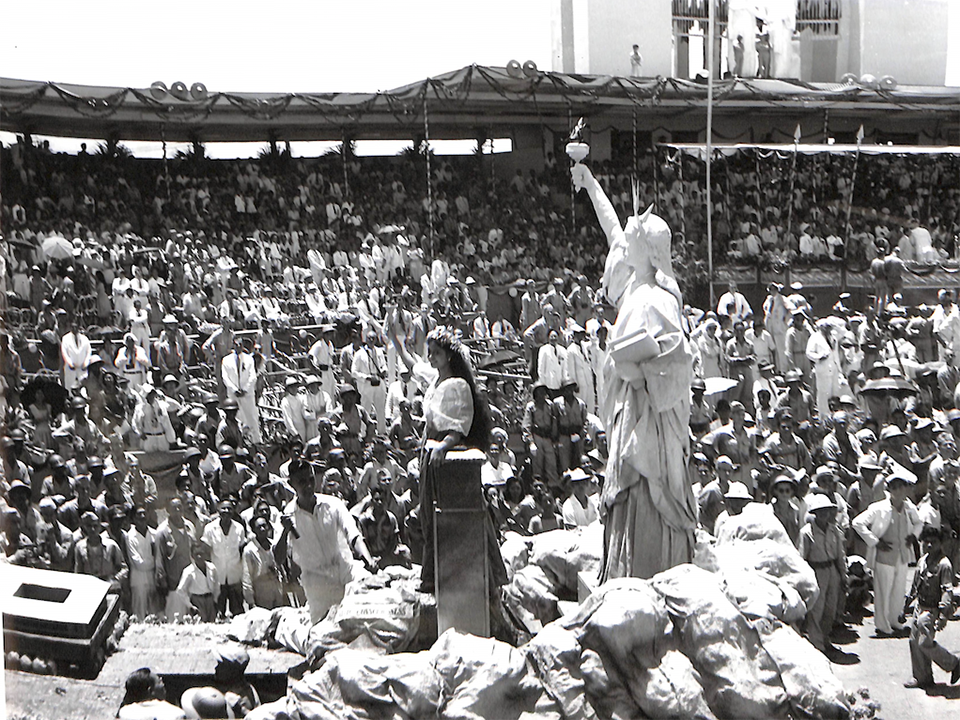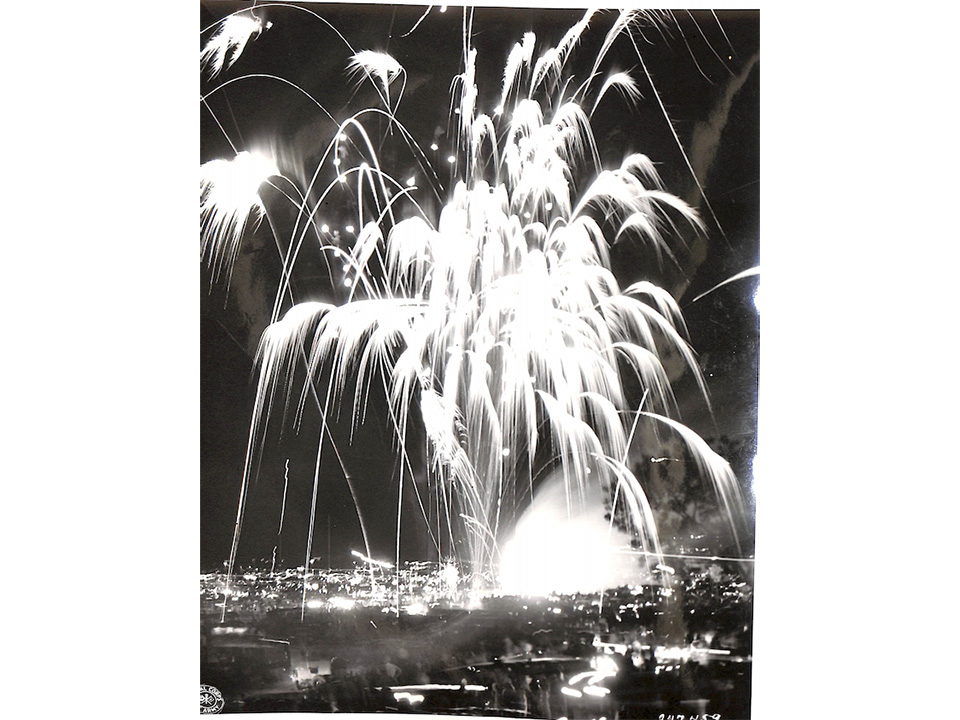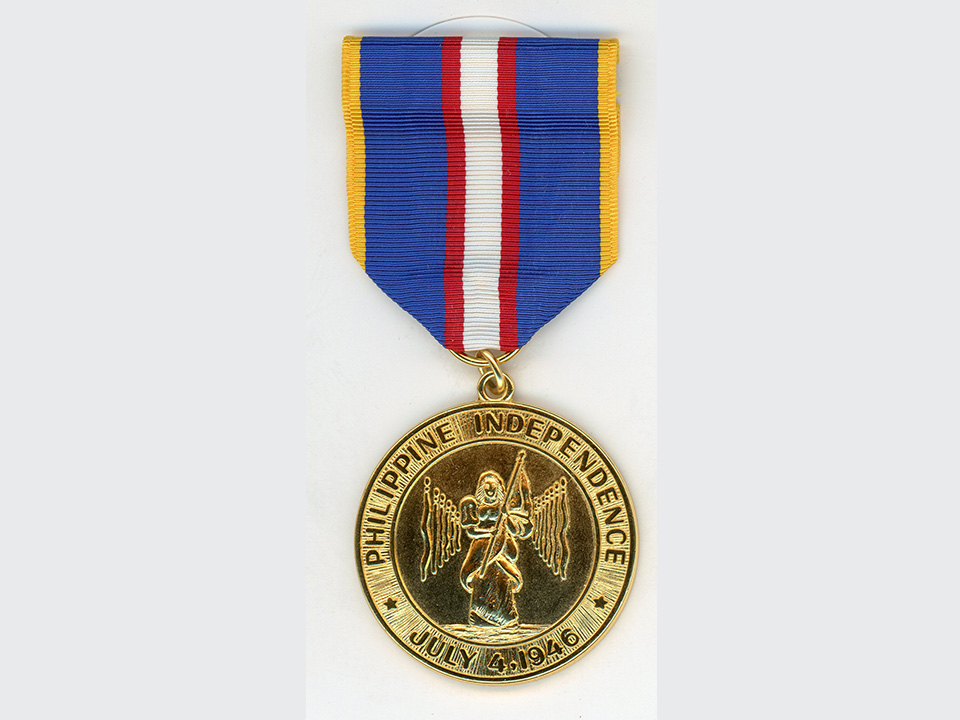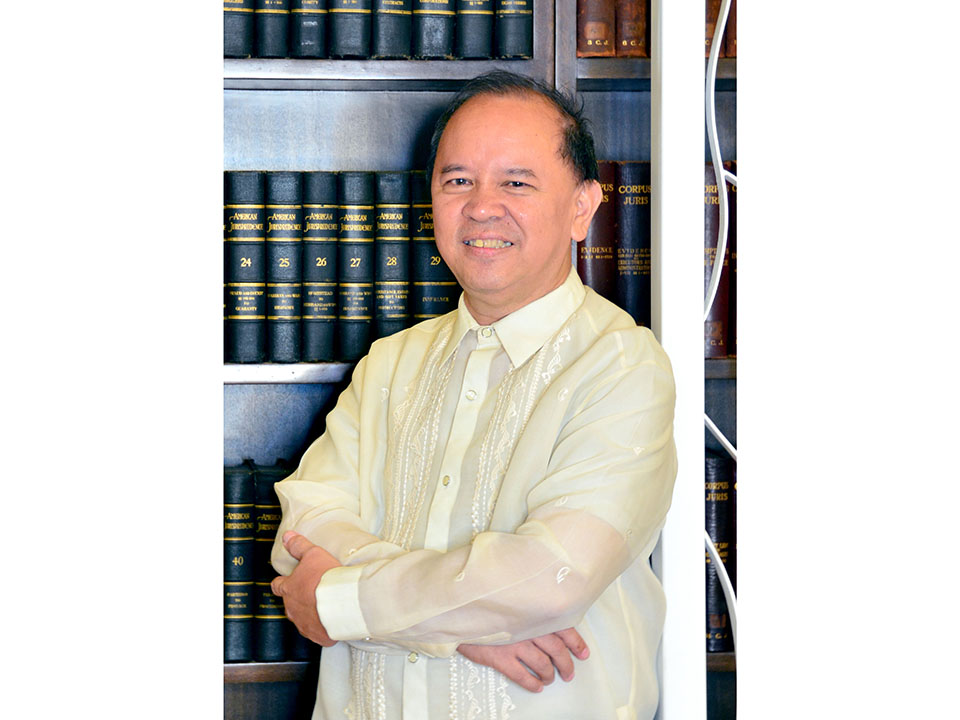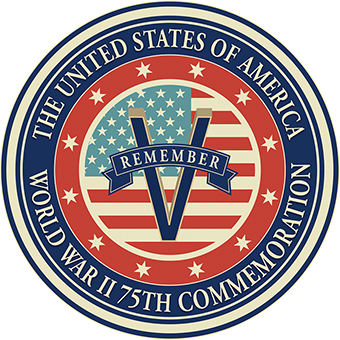Top Image: Commemorative stamps celebrating Independence Day from the collection of Dr. Ricardo T. Jose.
The 4th of July used to be considered an important national holiday in the Philippines. Not because it was the United States’ birthday, but because it was Philippine Independence Day in 1946. Seventy five years ago, the Philippines was recognized as an independent, sovereign country by the United States, which withdrew its authority over the archipelago as colonizer.
Pre-Independence History of the Philippines
The road to July 4, 1946 was long and tenuous. The Philippines had been a Spanish colony since 1565, and since that time numerous revolts broke out challenging Spanish rule. These revolts were disunited, however, until the nineteenth century when nationalism brought forth a more united anti-colonial movement. This culminated in a revolution that broke out in 1896. After much fighting, a stalemate ensued, leading to a ceasefire agreement between Filipino and Spanish leaders.
The outbreak of the Spanish-American War in 1898 brought Commodore George Dewey and the US Asiatic Squadron to Manila Bay, where they defeated the Spanish Asiatic fleet. The Philippine Revolution resumed in earnest, led by General Emilio Aguinaldo who established a revolutionary government. At the height of its military successes against Spain, the revolutionary government proclaimed independence on June 12, 1898. Aguinaldo became president and the Philippine Republic was formally inaugurated in Malolos, Bulacan, in January 1899.
The Spanish-American war was concluded by the Treaty of Paris which decreed that Spain would give up the Philippines, but in turn the archipelago would become a colony of the United States. Filipinos had not been consulted, and as a result the war for independence turned against the United States.
After over two years of fighting, Aguinaldo was captured and President Theodore Roosevelt declared the end of the Philippine-American War. The campaign for independence continued on the political front, even as sporadic violent resistance against American rule continued to break out.
In August 1916, the Jones Law, more formally known as the Philippine Autonomy Act of 1916, was passed, promising independence to the Philippines once Filipinos were able to prove that they could govern themselves. No timetable was set, but once the United States declared war on Germany in World War I, Philippine political leaders offered a division of Filipinos to fight on the side of the United States. Filipinos were given great leeway in running the government at that time, but once the Great War ended, the US government reexamined Philippine conditions and strengthened American control of the insular government. Filipinos sent regular independence missions to Washington to call for concrete steps towards independence, which were rebuffed by the prevailing Republican administrations.
The advent of the Great Depression made Congress rethink US-Philippine relations, and passed the Hare-Hawes-Cutting Act in 1933, over President Herbert Hoover’s veto. The Hare-Hawes-Cutting Act (HHC) envisaged a 10 year transitory period during which time the Philippines would establish a semi-autonomous government under an elected Filipino president. The act was rejected by the Philippine Legislature later that year, after much debate and political wrangling. Manuel L. Quezon, President of the Philippine Senate, proceeded to Washington immediately after to negotiate a more advantageous law, citing among others issues relating to the continuance of US bases in the Philippines after independence, the limits of authority of the Philippine president in the transitory government, and the abrupt end of Philippine preferential trade relations with the United States.
1934 Philippine Independence Act
Quezon, the dominant political leader in the Philippines at that time, believed he could influence the new American president, Franklin D. Roosevelt, and the Democratic congress to rectify his main objections in a new Philippine independence bill. Roosevelt and the congress were busy with New Deal policies and were only willing to resuscitate the HHC with very minor changes. Quezon accepted these and returned to Manila. The ensuing act, the Tydings-McDuffie Law, was accepted by the Philippine legislature in May 1934, thus setting the stage for Philippine independence in 1946.
Under the Tydings-McDuffie Law, the Philippines would establish a government to be known as the Philippine Commonwealth, which would steer the Philippines through a 10-year transition period. After completing 10 years of nearly autonomous governance, the United States would withdraw its sovereignty over the islands on July 4 of the succeeding year, and would recognize the Philippines as an independent republic.
Prior to the establishment of the Philippine Commonwealth, a constitution had to be drafted. A constitutional convention was thus elected, and finished its draft in February 1935. Roosevelt approved this document, which was to become the legal framework not only of the Philippine Commonwealth, but also of the future Philippine Republic. It was approved in a nationwide plebiscite, and national elections for the new government were held in September 1935. The Philippine Commonwealth was formally inaugurated on November 15, 1935, an unprecedented world event in which the United States, a colonial power, was preparing to let go of its colony. The ramifications were keenly felt among other colonial governments and colonized people. Quezon was predictably elected as president.
The Philippine Commonwealth government had to resolve major problems during the 10-year transition period, among them national defense, social justice, economic development, national integration, and cultural identity. During the over three decades of American colonial rule, the Philippines had become dependent on the US economically, and had no armed forces of its own. These and major agrarian and labor problems had to be resolved. A Philippine Army was formed, and government enterprises in business were launched.
The Philippine Commonwealth was an untried experiment, and the Tydings-McDuffie Law appointed a representative of the US president in the form of a High Commissioner. Gone was the Governor General of earlier years. The High Commissioner would report on the progress of the Philippine experiment, and the US government had oversight functions over legislative, executive, and judicial actions of the Commonwealth. Furthermore, the US government held on to foreign affairs and currency matters. In case the experiment failed, the transition could be scrapped and it would be back to square one. Neither Quezon nor Roosevelt wanted this, so despite much power granted him, Quezon held back where he could.
World War II and the Filipino Guerrilla Movement
Halfway through the experiment, World War II broke out in Europe. Trade was disrupted, and the reality of war reaching the Philippines loomed. The gravity of some problems delayed enforcement of various plans, and some began to ask whether 10 years were enough. Quezon, however, attempted to advance independence at least privately, although this did not bear fruit.
The outbreak of war between Japan and China in 1937 also brought forth the specter of war, through refugees and news of defenseless cities being bombed. But it was the war in Europe that seemed closer: The European capitals were better known to most Filipinos, and the Blitzkrieg and the Battle of Britain became household words.
War did reach the Philippines in December 1941, although strenuous last-minute preparations were made. The US Army Forces in the Far East was created, placing under one command the US Army forces in the Philippines and the mobilized Philippine Army forces. Gen. Douglas MacArthur was placed in command, and modern aircraft and weapons were rushed to the Philippines. It was too late.
The Japanese struck before the defense preparations were completed, decimating the US air forces and naval facilities in the first days of the war. Beach defenses were unable to hold against the Japanese juggernaut, but a fighting withdrawal to Bataan and Corregidor was successful and held against all odds. Realizing the hopelessness of the situation, Roosevelt ordered MacArthur to Australia; the Philippine Commonwealth government, which had moved to Corregidor to save Manila from bombing, was itself also removed. Quezon would establish the Commonwealth government in exile in Washington as Bataan and Corregidor were forced to surrender. Roosevelt had, in the meantime, promised to redeem Philippine freedom and to pay for war damages,
For three years the Philippines was in the hands of the Japanese, who set up a military administration. Wanting to win Filipino loyalty, the Japanese declared the Philippines independent in 1943, ahead of the US promise. A government was set up, but most Filipinos saw through the Japanese aims and instead supported the guerrilla resistance movement. The guerrillas remained loyal to the Philippine Commonwealth and the United States, and were a major threat to the Japanese occupation forces.
Liberation of the Philippines from the Japanese
Gen. MacArthur, who had promised to return, landed in Leyte in October 1944, thus commencing the military campaign to liberate the Philippines from the Japanese. In the ensuing struggle, Manila and most of the major Philippine cities suffered grievous damage. MacArthur declared the military campaign on Luzon closed on July 4, 1945, but the bulk of the Japanese ground forces were still intact in the mountains. Fighting continued in Mindanao. And Japan had not yet surrendered.
The Philippine Commonwealth government returned with Gen. MacArthur. Quezon had died while in the United States, and Sergio Osmeña, the vice president, automatically took over. Osmeña landed with MacArthur on Leyte, and as the Battle of Manila neared its end, restored the government to Malacañang Palace in Manila. While in Washington, the Commonwealth government did all it could to hasten the return of American forces to the Philippines. It also sought to ensure that war damage would be rehabilitated by the US government. The Philippines actively participated in the early meetings that would result in the United Nations.
Upon his return to Manila, Osmeña pledged a Philippine Army division to participate in the assault landings on Japan. Guerrillas, now part of the army, trained accordingly. The atomic bombs negated the need for such action, and Japan accepted the Allied terms on August 15, 1945.
Post-war Rehabilitation
As the war ended, the Philippines counted the cost. Over a million Filipinos had died or were killed, out of a population of 18 million. Manila and most of the major cities were in ruins. Severe inflation had set in as a result of the Japanese occupation, and farms were fallow; farm animals too had died because of the war. Industries, transportation, and communication facilities were destroyed.
Should the original timetable for independence be kept? The tasks facing Osmeña and the Commonwealth government were daunting; none of this had been foreseen when the Tydings-McDuffie Act had become law.
Apart from the physical destruction and the loss of lives, the Philippines was divided: there had been those who had collaborated with the Japanese, while most had resisted either directly or indirectly. The country was split on whether the collaborators were to be dealt with harshly or not. Many key government officials from before the war had—willingly or not—served in the Japanese-controlled administration.
There was an immediate need for relief. People had to be fed, clothed, and given shelter. All the basic necessities were initially provided by the US Army—water, clothing, food, power, communications, and jobs. Other assistance came in from the United States and the United Nations Relief and Rehabilitation Administration as the piers were restored, and ships arrived.
Peace and order problems were serious—some stemming from the pre-war social and agrarian issues, others because of loose firearms. Guerrilla units were plenty, but not all were legitimate, and there was an upsurge of crimes. Morality was in tatters, as people had to survive in whatever ways they could. Inflation was rampant, even as the government strove to bring prices down with newly printed currency and price controls. Besides, after having been away for three years, it was a difficult task to win back the people’s confidence in the government.
The Philippine Congress was convened in June 1945—the first time it sat since the elections of November 1941. Some of its members had died during the war; others were tainted by charges of collaboration. It began its work of legislating, but was hampered by the unstable postwar conditions.
Osmeña travelled to the United States three times in 1945—a last meeting with FDR in April and two meetings with President Harry S. Truman, to negotiate aid and assistance for the Philippines—as well as assurances that independence would come as scheduled.
For a while an earlier independence date was broached, but this would have required legislation which was not a priority. There were mutterings that Philippine independence be delayed, owing to the unsettled conditions after the war, but this would mean political suicide to those seeking office. And so independence would take place as planned, on July 4, 1946.
The post-war Philippine Commonwealth faced severe problems not anticipated before the war. Land reform, reopening of schools, reconstruction, trials of suspected collaborators with the Japanese, recognizing and compensating veterans, restarting the economy, restoring trade, attracting investment—these and more had to be dealt with in the last months of the Philippine Commonwealth government.
The government was now more strongly reliant on the United States, more so than before the war. The Philippine Army was totally dependent on the US Army for equipment and weapons, and relief only coming from the United States. External defense would now be too costly for the cash-strapped government. Thus the presence of US bases could be seen as mutually beneficial.
The last American High Commissioner was Paul V. McNutt, who had served in that position in the late 1930s. He advised Osmeña on various matters. Secretary of State Harold Ickes insisted that the Philippines take a hard line on alleged collaborators—something that would be difficult to do due to the many issues involved. Ickes threatened to withhold assistance if the government did not punish those who had reneged on their oaths of loyalty to the United States.
Paul McNutt, High Commissioner to the Philippines, reads a proclamation at the ceremony. US Signal Corps photograph from the collection of Dr. Ricardo T. Jose.
An ally of the Philippines in Washington was Senator Millard Tydings, co-author of the pre-war Philippine Independence Act. He sponsored a bill granting what he felt were sufficient funds for rehabilitation. On a personal visit to the Philippines, however, he found out that earlier estimates had been underestimated, and that more funds were needed. His bill did allot a generous $620 million—later raised to $800 million—to the Philippines.
The Rehabilitation Bill was, however, tied to a trade bill, authored by Representative Jasper Bell. The Bell Trade bill sought to extend the free trade relations between the United States and the Philippines for another eight years, after which tariffs would be gradually imposed for 20 years. Bell insisted that to convince Americans to invest in the Philippines they had to be given the same rights as Filipinos. This necessitated amending the 1935 Philippine constitution, which limited land ownership, access to natural resources, among others, to Filipino citizens and majority Filipino-owned corporations. The parity amendment would thus become a requisite for receiving the bulk of the rehabilitation aid in the Tydings bill. The Bell Trade Bill also tied the Philippine peso to the US dollar and could not be independently revalued.
Other issues that emerged on the eve of independence. In February 1946, President Truman signed the Rescission Law, which denied most Filipino veterans of benefits due them, voiding their service in the US armed forces.
A strong US military presence remained in early 1946, with the 86th Infantry Division in full strength, prepared to protect American interests. With World War II over, many of its members felt their duty was done and rallied to be sent home. But there was discontent brewing in the provinces, with long agrarian issues remaining unsolved. Many military bases were still in US hands, and negotiations as to which would be kept after Philippine independence were begun. As set in the Tydings-McDuffie Act, the United States would maintain bases even after Philippine independence to protect American interests in the region.
Philippine Commonwealth Election of 1946
As the date of independence approached, a multitude of problems had to be solved. Amidst the disunity, tension, and uncertainty of the immediate post-war Philippines, there had to be a final election for the Commonwealth. Osmeña chose to run for reelection; Manuel Roxas, ambitious contender and also Quezon’s own choice as successor, ran against him. While Roxas had participated in the defense of the Philippines, he had also served in the Japanese-sponsored government under Jose P. Laurel. To some he was tainted with collaboration and might bring other collaborators back to power. Osmeña was the guerrillas’ choice, and also the peasants; Osmeña leaned left of center. But Roxas was backed by McNutt and General MacArthur.
Roxas won the election of April 1946, but by only a slim margin, garnering some 54 percent of the votes cast. He took his oath of office on May 28, 1946, in a temporary stage built in front of the ruins of the Legislative Building, as the third and last president of the Philippine Commonwealth.
Prior to his assumption of office, Roxas went to the United States via Tokyo, where he paid a visit to MacArthur. Roxas’ Washington visit was a frenzied week-long one, meeting with President Truman and ranking American officials to discuss Philippine affairs and concretize plans for US assistance to the Philippines.
As Roxas took office, conservative congressmen ousted more liberal legislators on unfounded charges. It marked a split between peasant leaders who were open to pursuing change in the government and conservatives who felt threatened by them. On the eve of Philippine independence, left-leaning peasant and labor groups threatened to secede and launch a rebellion, reacting to the blatant politicization of the congress.
Philippine Independence Day 1946
This was a big international event, but the Philippines did not yet have a Department of Foreign Affairs. It had to rely on the US government for much of the preparations.
May 1946 saw the start of a flurry of events to plan out the final days of the Commonwealth and prepare for Independence Day. A joint Filipino-American committee was formed to iron out details. The Manila Hotel, which had been gutted during the Battle of Manila, was cleaned up and prepared for gala events. Invitations were issued to distinguished guests from the United States and various countries. President Truman was invited, but he declined, owing to pressure of work. Independence related contests were launched—for an appropriate poster, essay, poem, and hymn. A US flag was to be hand-sewn by past and present Philippine first ladies, to be presented to President Truman. Commemorative postage stamps, medals, and other souvenirs were issued.
The venue for the independence rites was chosen and a stage shaped in the form of a ship’s prow (symbolizing the ship of state) was built with towering pillars behind it. The stage and grandstand were built in front of the iconic memorial of the Philippine national hero, Jose Rizal, in Luneta Park. A large arch was erected near it, in front of the Manila Hotel, to welcome visitors.
As the month of July 1946 began, so did the numerous events and preparations to climax in Philippine Independence on July 4. Private homes and government buildings were decorated. Bands paraded and gave concerts. The University of the Philippines’ Conservatory of Music held a gala concert at the Rizal Coliseum, where numerous international sports matches were held. Distinguished visitors from the US and other countries arrived. The US Navy’s Task Force 77 anchored in Manila Bay to salute the birth of the republic. It consisted of the flagship USS Bremerton, two aircraft carriers, two cruisers, and seven destroyers.
Among the Very-Important-Persons who arrived in the first days of July was General MacArthur, who flew from Tokyo. Representing the US government was High Commissioner McNutt, now destined to be the first US Ambassador to the Republic of the Philippines. From the United States were Senator Tydings, Representative Bell, US Postmaster General Robert E. Hannegan, former Governor General Francis B. Harrison, and others. Representatives from 27 nations arrived, among them the French WWI hero Lt. Gen. Zinovi Peckoff (at that time serving with the Supreme Commander for the Allied Powers in Tokyo) and Lt. Gen. Sook Chatinakrob, Thailand’s Chief of Staff. In Manila Bay were Australian, Portuguese and Thai warships.
All these activities were taking place as the Cold War began: the United States tested an atomic bomb in Bikini Atoll on July 1. Communist-linked movements were beginning to threaten the post-war order.
On July 3, the Philippine Congress accepted the Bell Trade Act and authorized President Roxas to sign an executive agreement with the US laying the groundwork for formal negotiations and mutual recognition. That same day, Roxas and McNutt visited the commander of Task Force 77 on his flagship; later they recorded messages to be broadcast nationwide and to the United States. McNutt hosted a reception at his official residence and capped the day with a formal dinner in honor of Roxas at the Manila Hotel.
Thursday, July 4 1946, was a cloudy, sunless day. It was the rainy season in the Philippines, but this did not dampen the excitement building up towards the Philippine independence ceremony. Religious services were held in the various churches of Manila and provincial capitals, cities, and towns. Guests began arriving at the venue shortly before 7:00 in the morning. Dignitaries arrived from 7:20; the crowd craned their necks to get a glimpse of Gen. MacArthur. A bugle sounded, and the audience rose to welcome President Roxas and his wife at 7:55. He was followed by Vice President Elpidio Quirino and finally High Commissioner McNutt, accompanied by their respective wives.
With McNutt serving as emcee, the program began at precisely 8:00 am. The Rt. Rev. Robert F. Wilmer, ranking Protestant in the Philippines, gave the invocation. McNutt then introduced the speakers; there were wild cheers for Senator Tydings and Gen. MacArthur. Tydings reviewed the events which led to this day, and then wished the new republic “Godspeed.” MacArthur reviewed the “special relationship” between the Philippines and the United States.
The highlight of the program was McNutt’s reading of President Truman’s Proclamation of Independence. As he began speaking, a heavy downpour drenched the audience, but they braved the rain. The downpour lifted in time for McNutt to read the proclamation, which first laid out the legal basis for the United States’ acquisition of the Philippines, the United States’ desire to grant the Philippines independence, and the provisions of the Tydings McDuffie Act. Truman, as president of the United States, then withdrew all “rights of possession, supervision, jurisdiction, control or sovereignty” exercised by the United States over the territory and people of the Philippines, and recognized the independence of the Philippines.
McNutt ended with his own words:
“A new nation is born. Long live the Republic of the Philippines. May God bless and prosper the Philippine People, keep them safe and free.”
Paul V. McNutt
At 9:15 am, the US Army band played the US National Anthem as McNutt began lowering the American flag. President Roxas, pulling on the same cord, began raising the Philippine flag, to the accompaniment of the Philippine National Anthem, played by the Philippine Army Band.
As the United States and Philippine flags passed each other, they touched—“as if in a last caress, a last kiss,” wrote one witness. As the Philippine flag fluttered from the top of the flagpole, United States, Australian, Portuguese, and Thai warships in the bay fired a 21-gun salute. Church bells throughout the Philippines rang and a whistle announced that the Philippines was now independent.
Vice President Quirino then took his oath, followed by President Roxas. These were administered by Chief Justice Manuel V. Moran of the Philippine Supreme Court. Roxas proceeded with his inaugural address: “As we are masters of our own destiny, so too must we bear all the consequences of our actions,” he announced. The Philippines was no longer protected by the mantle of American sovereignty and thus “we must find our own way… [but in the atomic age] we cannot retreat within ourselves… On all fronts the doctrine of absolute sovereignty is yielding ground… But we have yet a greater bulwark today… the friendship and devotion of America… Our safest course is in the glistening wake of America whose sure advance with mighty prow breaks for smaller craft the waves of fear.”
The future direction of the Philippines under President Roxas was thus charted, and to highlight this orientation he and McNutt signed an agreement for the establishment of diplomatic relations and an interim trade agreement. Roxas now signed as president of the Republic of the Philippines, and McNutt as first US ambassador.
A chorus of one thousand voices—college students all—then sang the Philippine Independence Hymn. This had been the winner of the independence hymn contest composed by acclaimed composer Restie Umali. The official program ended with a closing Invocation by Most Reverend Gabriel Reyes, Filipino archbishop of Cebu.
As the program ended, a bugle call sounded at 11:00 am to signal the start of the civic-military parade. Units from the Philippine and US armed forces marched in splendor, followed by Filipino veterans of the 1890s revolution and WWII guerrilla members. As the aged revolutionary war veterans marched past the grandstand, US bombers and fighters flew overhead, spelling first a V for Victory, and then the letters P and R, representing the Philippine Republic.
The military contingents were followed by several floats from different government offices and schools. Of note was that of the General Auditing Office, represented by a bulldog watching over a safe. The last float contained figures of Filipinas (representing the Philippines) and Miss Columbia, representing liberty.
By noon the ceremony was over, and the dignitaries and audience retired. The day was not yet over, however. At 4:30 pm a tree symbolizing Philippine independence was planted in front of the Manila City Hall. At 7:00 pm President Roxas hosted a formal dinner, reception, and ball at the presidential palace. The historic day was capped by a grand fireworks display at the Sunken Gardens just outside the old Walled City of Intramuros, as US Navy ships put up a searchlight display and pyrotechnics show in Manila Bay.
Celebrations continued for two more days: in the afternoon of July 5, a Philippine sports exhibition was held at the University of Santo Tomas Gymnasium. That evening, a Gala Symphony Concert by the Manila Symphony Orchestra, was held at the Rizal Coliseum. The final celebration of the momentous week was a Barrio Fiesta—a dinner feast—in the evening of July 6 at the Manila Hotel.
1946 to Present Day
It was a time of great rejoicing. But as the new era dawned, there were numerous sticking points—the US bases, the Bell Trade Act, Philippine war damage claims, and discriminatory treatment of Filipino WWII veterans. The Military Bases Agreement was to last for 99 years, during which period there was no clear cut guarantee that these bases would protect the Philippines. The bases agreement was shortened in 1966, and finally lapsed in 1991. The Bell Trade Act extended free trade and required the granting of parity rights to American nationals, which in turn required amending the 1935 Constitution, which had reserved numerous rights to only Filipino citizens. Free trade, with quota limitations, would continue on until 1954, after which gradual tariffs would be applied for a period of 20 years, ending in 1974. Parity rights were granted American citizens after stormy debates which almost cost President Roxas his life. The Bell Trade Act also tied the peso to the US dollar until 1955.
July 4, 1946 thus saw the birth of the Philippine Republic, but with lots of unfinished business. And this amidst the backdrop of the developing Cold War, a civil war, and deep rooted problems.
The independence that was gained (restored, according to some pundits, referring to the 1898 declaration) was questioned—was it a real, total independence? In addition, Philippine Independence Day celebrations coincided with US Independence Day, resulting in some confusion in the Philippines and abroad. In 1962, President Diosdado Macapagal moved Philippine Independence Day to June 12, commemorating the 1898 Filipino proclamation. Aguinaldo was then still alive and was happy to see the change. July 4 had been an afterthought, opined some, with June 12 the real Filipino act.
July 4 became Republic Day, still a national holiday, in 1964. During the period of Martial Law under President Ferdinand Marcos, July 4 was changed to Philippine-American Friendship Day, and relegated to a working holiday. President Corazon Aquino did away with Philippine-American Friendship Day altogether, but President Fidel V. Ramos restored it on the occasion of the 50th anniversary.
The event 75 years ago was much welcomed at the time and did see the end of formal aspects of colonial rule. There was no longer direct US oversight, no more American High Commissioner, the Philippine flag flew alone (except in the US bases) and the Philippine National Anthem was played alone. But critics argued that it ushered in a neo-colonial relationship. Some trumpeted the Philippine-American relationship as a “special relationship,” but it did not seem so to others.
July 4, 1946 was overshadowed by the events of World War II. Commemorations of the 75th anniversary of key WWII events were many and well publicized, but were suddenly stymied by the Covid-19 pandemic. The 1946 independence ceremonies have also been overtaken by rites commemorating the 500th anniversary of Magellan’s arrival—and the bringing in of Christianity to the Philippines, which was given full support by the Philippine Government and the Spanish government. Given the importance of July 4, 1946, however, it is sad to see the day not recognized for what it was.
Meet the Author
Ricardo Trota Jose is professor of history at the University of the Philippines, Diliman. He obtained his bachelor’s and master’s degrees in history at U.P., and his PhD from the Tokyo University of Foreign Studies. He specializes in military and diplomatic history, with focus on the Japanese occupation of the Philippines. Jose has published widely in various journals and books. Among his major publications are The Philippine Army, 1935-1942 (Ateneo de Manila University Press, 1992) and Volume 7 (on the Japanese occupation of the Philippines) of the multi-volume Kasaysayan set (Reader’s Digest, 1998). He was awarded the Metrobank Foundation Outstanding Filipino in teaching in 2019.
This article is part of a series commemorating the 75th anniversary of the end of World War II made possible by the Department of Defense.
Cite this article:
MLA Citation:
APA Citation:
Chicago Style Citation:
